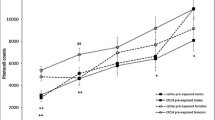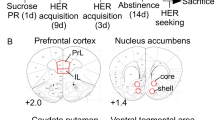Abstract
Objectives
Early onset of heroin use during adolescence might increase chances of later drug addiction. Prior work from our laboratory suggests, however, that adolescent male rats are actually less sensitive than adults to some enduring effects of heroin self-administration. In the present study, we tested two likely correlates of sensitivity to behavioral reinforcement in rats: physical withdrawal and locomotor sensitization.
Methods
Adolescent (35 days old at start) and adult (79 days old) male Sprague–Dawley rats were administered escalating doses of heroin, increasing from 1.0 to 8.0 mg/kg (i.p.) every 12 h, across 13 days. Somatic signs of spontaneous withdrawal were scored 12 and 24 h after the last injection, and then every 24 h for 5 days; locomotion was recorded concurrently. Challenge injections of heroin (1 mg/kg i.p.) were given at four points: as the first of the escalating doses (day 1), at days 7 and 13 during the escalating regimen, and after 12 days of forced abstinence. Body mass and food intake were measured throughout experimentation.
Results
A heroin withdrawal syndrome was not observed among adolescents as it was among adults, including somatic signs as well as reduced locomotion, body mass, and food intake. On the other hand, heroin-induced locomotor sensitization did not differ across ages.
Conclusion
Reduced withdrawal is consistent with the attenuated reinforcing effects of heroin among adolescent male rats that we reported previously. Thus, it is possible that adolescent rats could reveal important neuroprotective factors for use in treatment of heroin dependence.






Similar content being viewed by others
References
Anthony JC, Petronis KR (1995) Early-onset drug use and risk of later drug problems. Drug Alcohol Depend 40:9–15
Antonilli L, Petecchia E, Caprioli D, Badiani A, Nencini P (2005) Effect of repeated administrations of heroin, naltrexone, methadone, and alcohol on morphine glucuronidation in the rat. Psychopharmacology (Berl) 182:58–64
Antonilli L, Suriano C, Paolone G, Badiani A, Nencini P (2003) Repeated exposures to heroin and/or cadmium alter the rate of formation of morphine glucuronides in the rat. J Pharmacol Exp Ther 307:651–660
Azar MR, Ahmed SH, Lintz R, Gutierrez T, Stinus L, Koob GF (2004) A non-invasive gating device for continuous drug delivery that allows control over the timing and duration of spontaneous opiate withdrawal. J Neurosci Methods 135:129–135
Bläsig J, Herz A, Reinhold K, Zieglgänsberger S (1973) Development of physical dependence on morphine in respect to time and dosage and quantification of the precipitated withdrawal syndrome in rats. Psychopharmacology (Berl) 33:19–38
Cicero TJ, Nock B, Meyer ER (2002) Gender-linked differences in the expression of physical dependence in the rat. Pharmacol Biochem Behav 72:691–697
Clark DB, Kirisci L, Tarter RE (1998) Adolescent versus adult onset and the development of substance use disorders in males. Drug Alcohol Depend 49:115–121
Doherty J, Frantz K (2012) Heroin self-administration and reinstatement of heroin-seeking in adolescent vs. adult male rats. Psychopharmacology (Berl) 219:763–773
Doherty J, Ogbomnwan Y, Williams B, Frantz K (2009) Age-dependent morphine intake and cue-induced reinstatement, but not escalation in intake, by adolescent and adult male rats. Pharmacol Biochem Behav 92:164–172
Doremus TL, Brunell SC, Varlinskaya EI, Spear LP (2003) Anxiogenic effects during withdrawal from acute ethanol in adolescent and adult rats. Pharmacol Biochem Behav 75:411–418
Epstein D, Preston K, Stewart J, Shaham Y (2006) Toward a model of drug relapse: an assessment of the validity of the reinstatement procedure. Psychopharmacology (Berl) 189:1–16
Frantz KJ, O’Dell LE, Parsons LH (2007) Behavioral and neurochemical responses to cocaine in periadolescent and adult rats. Neuropsychopharmacology 32:625–637
Frenois F, Le Moine C, Cador M (2005) The motivational component of withdrawal in opiate addiction: role of associative learning and aversive memory in opiate addiction from a behavioral, anatomical and functional perspective. Rev Neurosci 16:255–276
Garrido MJ, Valle M, Calvo R, Troconiz IF (1999) Altered plasma and brain disposition and pharmacodynamics of methadone in abstinent rats. J Pharmacol Exp Ther 288:179–187
Gellert VF, Holtzman SG (1978) Development and maintenance of morphine tolerance and dependence in the rat by scheduled access to morphine drinking solutions. J Pharmacol Exp Ther 205:536–546
Glover EM, Davis M (2008) Anxiolytic-like effects of morphine and buprenorphine in the rat model of fear-potentiated startle: tolerance, cross-tolerance, and blockade by naloxone. Psychopharmacology (Berl) 198:167–180
Hodgson SR, Hofford RS, Wellman PJ, Eitan S (2009) Different affective response to opioid withdrawal in adolescent and adult mice. Life Sci 84:52–60
Infurna RN, Spear LP (1979) Developmental changes in amphetamine-induced taste aversions. Pharmacol Biochem Behav 11:31–35
Johnston LD, O’Malley PM, Bachman JG, Schulenberg JE (2010) Monitoring the Future national results on adolescent drug use: overview of key findings, 2009. NIH Publication No. 10–7583
Kandel DB, Yamaguchi K, Chen K (1992) Stages of progression in drug involvement from adolescence to adulthood: further evidence for the gateway theory. J Stud Alcohol 53:447–457
Kenny PJ, Chen SA, Kitamura O, Markou A, Koob GF (2006) Conditioned withdrawal drives heroin consumption and decreases reward sensitivity. J Neurosci 26:5894–5900
Koek W, France C, Javors M (2012) Morphine-induced motor stimulation, motor incoordination, and hypothermia in adolescent and adult mice. Psychopharmacology (Berl) 219:1027–1037
Koob GF, Maldonado R, Stinus L (1992) Neural substrates of opiate withdrawal. Trends Neurosci 15:186–191
Lenoir M, Ahmed SH (2007) Heroin-induced reinstatement is specific to compulsive heroin use and dissociable from heroin reward and sensitization. Neuropsychopharmacology 32:616–624
Li C, Frantz KJ (2009) Attenuated incubation of cocaine seeking in male rats trained to self-administer cocaine during periadolescence. Psychopharmacology (Berl) 204:725–733
Liu Y, Morgan D, Roberts DC (2007) Cross-sensitization of the reinforcing effects of cocaine and amphetamine in rats. Psychopharmacology (Berl) 195:369–375
Lorrain DS, Arnold GM, Vezina P (2000) Previous exposure to amphetamine increases incentive to obtain the drug: long-lasting effects revealed by the progressive ratio schedule. Behav Brain Res 107:9–19
MacLeod SM, Renton KW, Eade NR (1972) Development of hepatic microsomal drug-oxidizing enzymes in immature male and female rats. J Pharmacol Exp Ther 183:489–498
Maldonado R, Negus S, Koob GF (1992) Precipitation of morphine withdrawal syndrome in rats by administration of mu-, delta- and kappa-selective opioid antagonists. Neuropharmacology 31:1231–1241
Natividad L, Tejeda H, Torres O, O’Dell L (2010) Nicotine withdrawal produces a decrease in extracellular levels of dopamine in the nucleus accumbens that is lower in adolescent versus adult male rats. Synapse 64:136–145
O’Connor PG, Fiellin DA (2000) Pharmacologic treatment of heroin-dependent patients. Ann Intern Med 133:40–54
O’Dell LE, Bruijnzeel AW, Smith RT, Parsons LH, Merves ML, Goldberger BA, Richardson HN, Koob GF, Markou A (2006) Diminished nicotine withdrawal in adolescent rats: implications for vulnerability to addiction. Psychopharmacology (Berl) 186:612–619
O’Dell LE, Torres OV, Natividad LA, Tejeda HA (2007) Adolescent nicotine exposure produces less affective measures of withdrawal relative to adult nicotine exposure in male rats. Neurotoxicol Teratol 29:17–22
Palmer RH, Young SE, Hopfer CJ, Corley RP, Stallings MC, Crowley TJ, Hewitt JK (2009) Developmental epidemiology of drug use and abuse in adolescence and young adulthood: Evidence of generalized risk. Drug Alcohol Depend 102:78–87
Pan YX, Xu J, Xu M, Rossi GC, Matulonis JE, Pasternak GW (2009) Involvement of exon 11-associated variants of the mu opioid receptor MOR-1 in heroin, but not morphine, actions. Proc Natl Acad Sci USA 106:4917–4922
Paolone G, Conversi D, Caprioli D, Del Bianco P, Nencini P, Cabib S, Badiani A (2007) Modulatory effect of environmental context and drug history on heroin-induced psychomotor activity and fos protein expression in the rat brain. Neuropsychopharmacology 32:2611–2623
Papaleo F, Contarino A (2006) Gender- and morphine dose-linked expression of spontaneous somatic opiate withdrawal in mice. Behav Brain Res 170:110–118
Pontieri FE, Calò L, Di Grezia R, Orzi F, Passarelli F (1997) Functional correlates of heroin sensitization in the rat brain. Eur J Pharmacol 335:133–137
Ranaldi R, Egan J, Kest K, Fein M, Delamater A (2009) Repeated heroin in rats produces locomotor sensitization and enhances appetitive Pavlovian and instrumental learning involving food reward. Pharmacol Biochem Behav 91:351–357
Robinson TE, Berridge KC (1993) The neural basis of drug craving: an incentive-sensitization theory of addiction. Brain Res 18:247–291
SAMHSA (2009) Substance Abuse and Mental Health Services Administration, results from the 2005 National Survey on Drug Use and Health: national findings. In: Department of Health and Human Services OoAS (ed), Rockville, MD
Schramm-Sapyta N, Cauley M, Stangl D, Glowacz S, Stepp K, Levin E, Kuhn C (2011) Role of individual and developmental differences in voluntary cocaine intake in rats. Psychopharmacology (Berl) 215:493–504
Shram MJ, Funk D, Li Z, Lê AD (2008a) Nicotine self-administration, extinction responding and reinstatement in adolescent and adult male rats: evidence against a biological vulnerability to nicotine addiction during adolescence. Neuropsychopharmacology 33:739–748
Shram MJ, Siu ECK, Li Z, Tyndale RF, Lê AD (2008b) Interactions between age and the aversive effects of nicotine withdrawal under mecamylamine-precipitated and spontaneous conditions in male Wistar rats. Psychopharmacology (Berl) 198:181–190
Solomon RL, Corbit JD (1974) An opponent-process theory of motivation: 1. Temporal dynamics of affect Psychol Rev 81:119–145
Spear LP, Horowitz GP, Lipovsky J (1982) Altered behavioral responsivity to morphine during the periadolescent period in rats. Behav Brain Res 4:279–288
Spear LP, Varlinskaya EI (2010) Sensitivity to ethanol and other hedonic stimuli in an animal model of adolescence: Implications for prevention science? Dev Psychobiol 52:236–243
Stewart J, Badiani A (1993) Tolerance and sensitization to the behavioral effects of drugs. Behav Pharmacol 4:289–312
Vanderschuren LJ, Kalivas PW (2000) Alterations in dopaminergic and glutamatergic transmission in the induction and expression of behavioral sensitization: a critical review of preclinical studies. Psychopharmacology (Berl) 151:99–120
Vanderschuren LJ, Pierce RC (2010) Sensitization Processes in Drug Addiction. Curr Top Behav Neurosci 3:179–195
Varlinskaya EI, Spear LP (2004) Acute ethanol withdrawal (hangover) and social behavior in adolescent and adult male and female Sprague–Dawley rats. Alcohol Clin Exp Res 28:40–50
Ventayol P, Busquets X, Garcia-Sevilla JA (1997) Modulation of immunoreactive protein kinase C-alpha and beta isoforms and G proteins by acute and chronic treatments with morphine and other opiate drugs in rat brain. Naunyn Schmiedebergs Arch Pharmacol 355:491–500
Vezina P, Pierre PJ, Lorrain DS (1999) The effect of previous exposure to amphetamine on drug-induced locomotion and self-administration of a low dose of the drug. Psychopharmacology (Berl) 147:125–134
Wang Y, Mitchell J, Moriyama K, Kim KJ, Sharma M, Xie GX, Palmer PP (2005) Age-dependent morphine tolerance development in the rat. Anesth Analg 100:1733–1739
Ward SJ, Lack C, Morgan D, Roberts DC (2006) Discrete-trials heroin self-administration produces sensitization to the reinforcing effects of cocaine in rats. Psychopharmacology (Berl) 185:150–159
White DA, Holtzman SG (2005) Periadolescent morphine exposure alters subsequent behavioral sensitivity to morphine in adult rats. Eur J Pharmacol 528:119–123
White D, Michaels C, Holtzman S (2008) Periadolescent male but not female rats have higher motor activity in response to morphine than do adult rats. Pharmacol Biochem Behav 89:188–199
Wilmouth CE, Spear LP (2004) Adolescent and adult rats’ aversion to flavors previously paired with nicotine. Ann N Y Acad Sci 1021:462–464
Yang YD, Zhang JZ, Sun C, Yu HM, Li Q, Hong M (2006) Heroin affects purine nucleotides catabolism in rats in vivo. Life Sci 78:1413–1418
Zhou Y, Leri F, Cummins E, Hoeschele M, Kreek MJ (2008) Involvement of Arginine Vasopressin and V1b Receptor in Heroin Withdrawal and Heroin Seeking Precipitated by Stress and by Heroin. Neuropsychopharmacology 33:226–236
Acknowledgments
The authors would like to thank Ebony Glover, Chen Li, Bonnie Williams, Patrick Dunigan, and Adria Lee for their excellent technical assistance. This research was supported in part by a National Institute on Drug Abuse B/START grant to KJF (1 RO3 DA020110-01), the Center for Behavioral Neuroscience NSF Science & Technology Center (IBN-9876754), and a seed grant from the Brains & Behavior Program at Georgia State University.
Author information
Authors and Affiliations
Corresponding author
Rights and permissions
About this article
Cite this article
Doherty, J.M., Frantz, K.J. Attenuated effects of experimenter-administered heroin in adolescent vs. adult male rats: physical withdrawal and locomotor sensitization. Psychopharmacology 225, 595–604 (2013). https://doi.org/10.1007/s00213-012-2847-1
Received:
Accepted:
Published:
Issue Date:
DOI: https://doi.org/10.1007/s00213-012-2847-1




